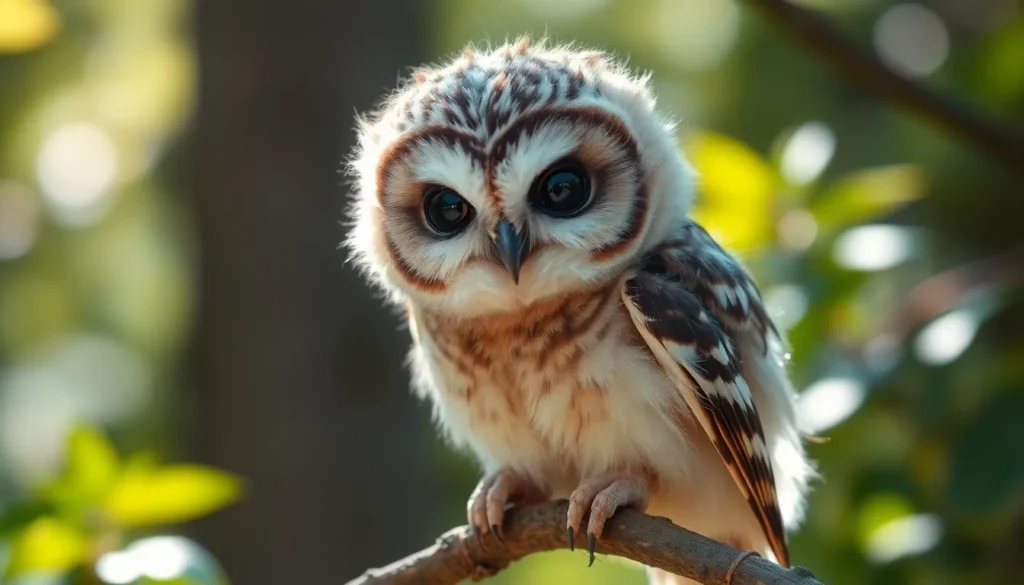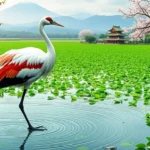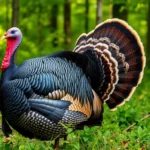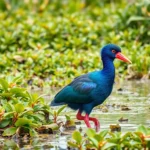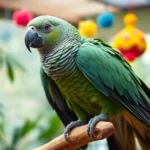Picture this: you’re scrolling through social media when suddenly a round ball of feathers appears on your screen. Your heart melts instantly. We’ve all been there – completely captivated by those adorably fluffy birds that seem too cute to be real. From baby owls that look like cotton balls with eyes to puffed-up sparrows battling winter weather these feathered friends have mastered the art of being irresistibly adorable.
But there’s more to fluffy birds than meets the eye. Behind that soft downy exterior lies fascinating science about thermoregulation survival tactics and evolutionary advantages. We’re diving deep into the industry of nature’s fluffiest creatures to uncover why some birds look like they’ve been through a dryer cycle.
Ready to discover which birds earn the title of “fluffiest” and learn the secrets behind their cloud-like appearance? Let’s explore the amazing industry of fluffy birds together.
What Makes a Bird Fluffy
The fluffy appearance that makes birds so endearing stems from specialized feather structures and adaptive mechanisms. Multiple factors contribute to a bird’s cloud-like texture, from microscopic feather components to seasonal survival strategies.
Feather Structure and Down
Down feathers create the signature fluffy appearance we find so captivating in birds. These specialized feathers lack the interlocking barbule system found in contour feathers, allowing individual barbs to separate and trap air effectively. Each down feather consists of a short rachis with many soft barbs that branch out in all directions, creating a three-dimensional structure resembling cotton balls.
The barbules on down feathers remain loose and flexible, preventing them from forming the flat surface typical of flight feathers. This loose arrangement maximizes the surface area available for air entrapment. Young birds possess particularly abundant down feathers, which explains why chicks and fledglings appear exceptionally fluffy compared to their adult counterparts.
Powder down represents another feather type that contributes to fluffiness in certain species like cockatoos and herons. These feathers continuously grow and disintegrate at their tips, producing a fine powder that conditions other feathers and adds to the bird’s overall soft appearance.
Seasonal Adaptations
Birds develop varying degrees of fluffiness throughout the year as temperatures change and breeding seasons approach. During winter months, many species grow additional down feathers beneath their outer plumage, creating increased insulation and a puffier appearance. This process, known as seasonal molt, allows birds to regulate their body temperature more efficiently.
Arctic species like snowy owls and ptarmigans exhibit extreme seasonal adaptations, growing dense down coverings that can make them appear twice their actual size. The fluffy appearance becomes most pronounced during the coldest months when survival depends on maintaining core body temperature.
Breeding season also influences fluffiness levels in certain species. Male birds often develop enhanced plumage displays that include fluffed feathers to attract mates. Young birds retain their downy appearance longer in species where extended parental care provides protection, allowing them to prioritize insulation over aerodynamic efficiency.
Most Popular Fluffy Bird Species
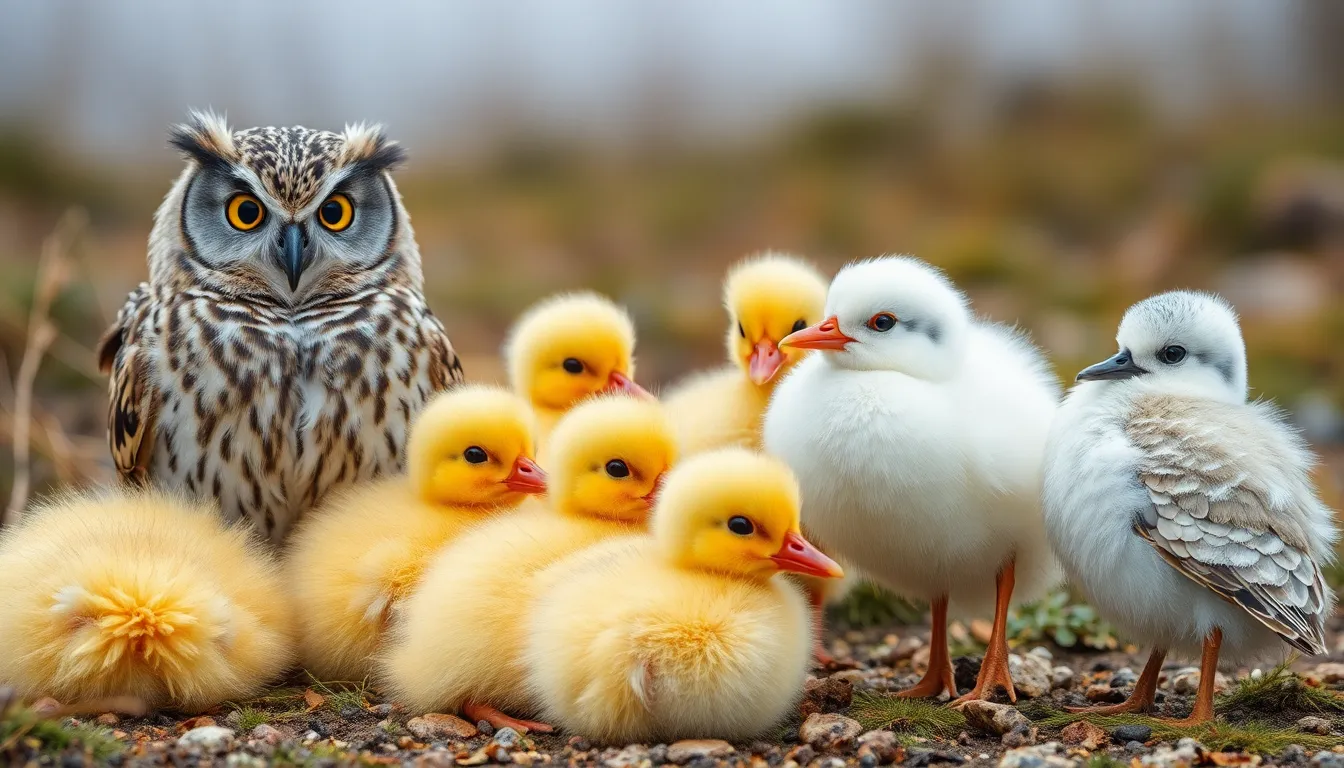
Certain bird species stand out for their exceptional fluffiness, capturing our attention with their downy appearances. These popular fluffy birds range from majestic nocturnal hunters to adorable young chicks.
Owls and Their Soft Plumage
Owls represent some of nature’s fluffiest adult birds, with their specialized feather structure creating remarkable softness. Barn owls possess dense facial disc feathers that enhance their fluffy appearance while improving sound detection. Great horned owls develop thick plumage layers that make them appear almost spherical during cold weather.
Snowy owls showcase extreme fluffiness adaptations, with feathers covering even their feet and toes for Arctic survival. Screech owls puff their feathers dramatically when threatened, transforming from compact hunters into fluffy defensive balls. Burrowing owls display adorable fluffiness particularly in juvenile stages, maintaining softer plumage longer than many other raptor species.
Short-eared owls demonstrate seasonal fluffiness variations, growing extra down layers during winter months. Tawny owls exhibit remarkable feather density, with approximately 10,000 individual feathers creating their signature fluffy silhouette.
Baby Birds and Chicks
Young birds achieve peak fluffiness through abundant down feather coverage that gradually disappears as they mature. Robin chicks emerge from eggs covered in sparse down that quickly develops into fluffy gray plumage within days. Duckling species like mallards and wood ducks display iconic yellow fluffiness that provides both insulation and water resistance.
Chickadee nestlings develop remarkably dense down coats, appearing as tiny fluffy spheres before their adult feathers emerge. Swan cygnets maintain their fluffy gray plumage for months, creating striking contrasts against their parents’ sleek white feathers. Penguin chicks represent extreme examples of fluffiness, with emperor penguin young sporting thick down coats that dwarf their parents in apparent size.
Eagle chicks display impressive fluffiness that gradually transitions to juvenile plumage over 8-12 weeks. Sparrow fledglings retain fluffy characteristics even after leaving the nest, maintaining softer feather textures than adult birds.
Cold Climate Birds
Arctic and alpine bird species exhibit the most extreme fluffiness adaptations for surviving harsh temperatures. Ptarmigans grow seasonal plumage that doubles their apparent body size during winter months. Snow buntings develop extra down layers that create rounded, fluffy silhouettes against snowy landscapes.
Snowy plovers adapt their fluffiness to match seasonal temperature demands, growing thicker plumage during migration periods. Arctic terns maintain consistent fluffiness throughout their lives, with specialized feather structures providing insulation during polar breeding seasons. Puffins showcase seasonal fluffiness variations, appearing more rounded and fluffy during winter ocean periods.
Rock ptarmigans demonstrate remarkable plumage transformations, changing from lean summer forms to extremely fluffy winter appearances. Gyrfalcons maintain consistent fluffiness year-round, with dense feather coverage enabling survival in northern territories where temperatures drop below -40°F.
Why Birds Develop Fluffy Feathers
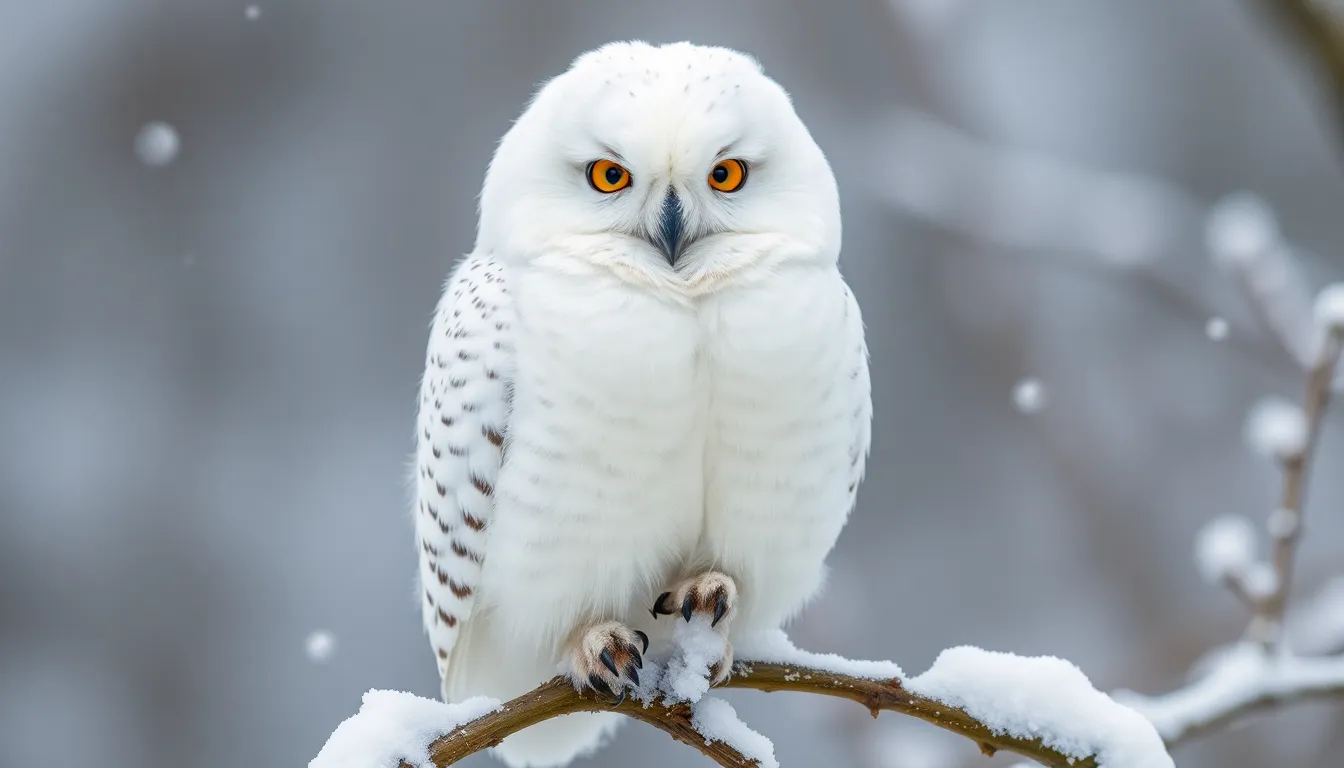
Birds develop fluffy feathers through evolutionary adaptations that address critical survival challenges. These specialized plumage structures serve multiple biological functions that enhance bird survival rates across diverse environments.
Insulation and Temperature Control
Down feathers create exceptional thermal regulation by trapping warm air close to a bird’s body. The loose structure of these feathers forms insulating air pockets that maintain core body temperature even when external temperatures drop below freezing.
Arctic species like snowy owls possess up to 70% more down feathers than temperate climate birds. This increased down density allows them to survive temperatures as low as -40°F without metabolic stress. Penguins demonstrate the most extreme adaptation with chicks carrying down layers that measure 2-3 inches thick.
Seasonal molting patterns enhance temperature control efficiency throughout the year. Many birds grow additional down feathers before winter arrives then shed excess insulation during spring warming periods. Ptarmigans exemplify this adaptation by increasing their feather weight by 35% between summer and winter months.
Body size influences insulation requirements with smaller birds needing proportionally more down coverage. Hummingbirds maintain feather densities of 25,000 feathers per square inch compared to larger birds that average 8,000-12,000 feathers per square inch. This density difference compensates for the higher surface area to volume ratio in small species.
Protection and Camouflage
Fluffy feathers provide physical protection against environmental hazards and predators. The soft texture cushions impacts during falls or collisions while creating a barrier against wind and precipitation. Young birds benefit most from this protective function as their flight capabilities remain underdeveloped.
Camouflage effectiveness increases significantly when fluffy feathers break up a bird’s outline against natural backgrounds. Owlet down feathers scatter light in multiple directions making exact body shapes difficult for predators to detect. Ground nesting species like grouse chicks rely on fluffy plumage that mimics surrounding vegetation textures.
Color patterns within fluffy feathers enhance concealment strategies across different habitats. Tawny owls display mottled brown down that blends seamlessly with tree bark while snowy owl chicks match surrounding snow and ice formations. These specialized colorations develop through genetic adaptations exact to each species’ primary nesting environments.
Parental recognition systems incorporate fluffy feather characteristics to identify offspring within large colonies. Penguin parents locate their chicks among thousands of similar looking young by recognizing exact down patterns and densities. This recognition ability prevents misdirected feeding efforts and ensures proper chick development rates.
Caring for Fluffy Birds as Pets
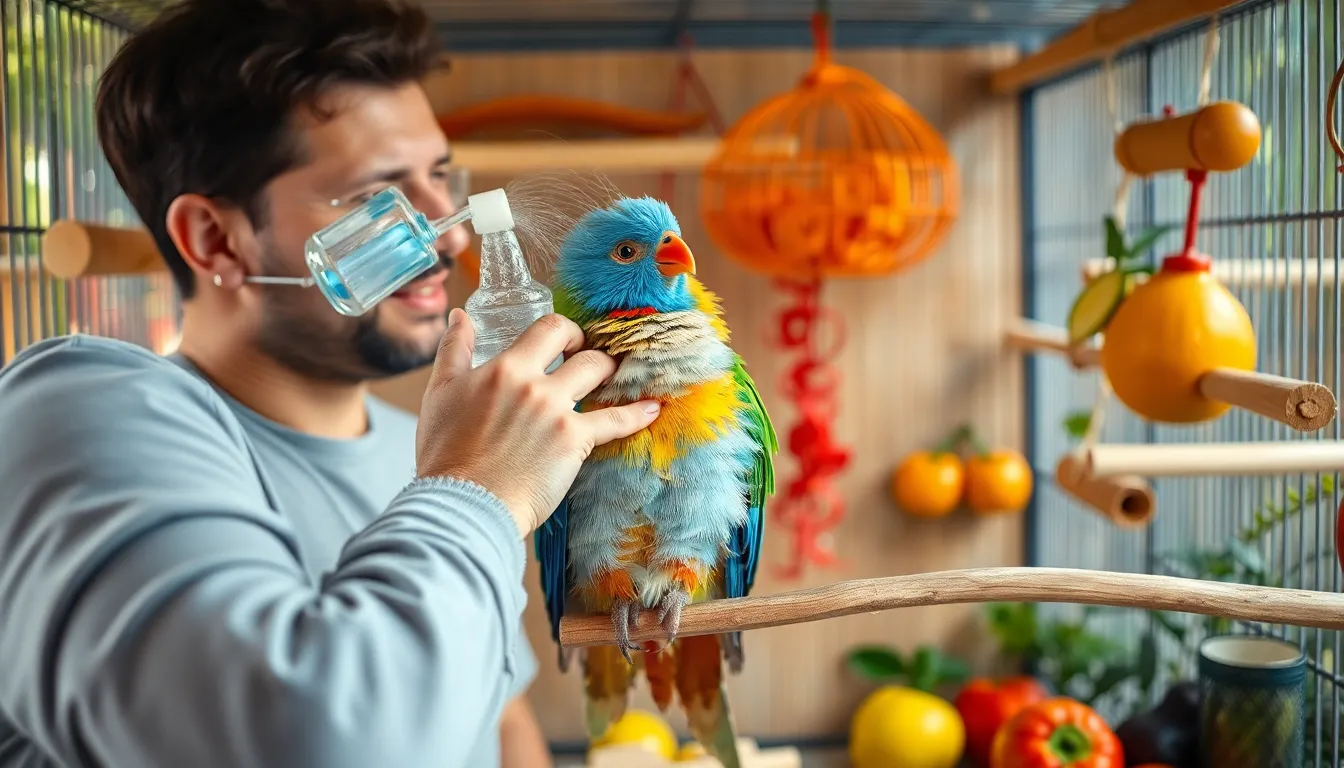
Fluffy birds require specialized care approaches that accommodate their unique feather structures and natural behaviors. Their down-heavy plumage demands exact environmental conditions and grooming routines to maintain optimal health.
Housing Requirements
Fluffy birds thrive in spacious enclosures that allow their voluminous feathers to move freely without compression. We recommend minimum cage dimensions of 36 inches wide by 24 inches deep by 30 inches high for medium-sized fluffy species like cockatiels and conures.
Temperature control becomes critical for fluffy bird species due to their enhanced insulation properties. Maintain ambient temperatures between 65°F and 75°F to prevent overheating while ensuring adequate warmth during cooler periods. Arctic-adapted fluffy birds such as canaries with enhanced winter plumage require temperatures on the lower end of this range.
Ventilation systems must provide consistent airflow without creating drafts that disturb delicate down feathers. Position perches at varying heights to accommodate natural roosting behaviors and prevent feather damage from cage bars. Natural wood perches with diameters ranging from 0.5 to 1.5 inches support proper foot health and feather maintenance.
Substrate selection impacts feather cleanliness significantly. Paper-based bedding materials absorb moisture effectively while preventing particles from adhering to fluffy plumage. Avoid cedar or pine shavings that release oils potentially harmful to respiratory systems enhanced by dense feather coverage.
Grooming and Maintenance
Fluffy birds engage in extensive preening behaviors that owners must understand and support through proper care techniques. Daily misting with lukewarm water helps maintain optimal feather condition by providing necessary moisture for natural oil distribution throughout their plumage.
Bathing opportunities require shallow dishes with water depths of 1 to 2 inches to accommodate different species’ preferences. Some fluffy birds prefer spray bottles for gentle misting while others enjoy shallow pan bathing. Observe individual preferences and adjust bathing methods accordingly.
Dietary supplements containing omega-3 fatty acids enhance feather quality and maintain the lustrous appearance of down feathers. Provide high-quality seed mixes supplemented with fresh fruits and vegetables to support proper feather development during molting cycles.
Environmental enrichment through foraging toys and climbing structures encourages natural behaviors that promote healthy feather maintenance. Rotate toys weekly to prevent boredom and ensure continued engagement with grooming-related activities that keep fluffy plumage in optimal condition.
Photographing Fluffy Birds in the Wild
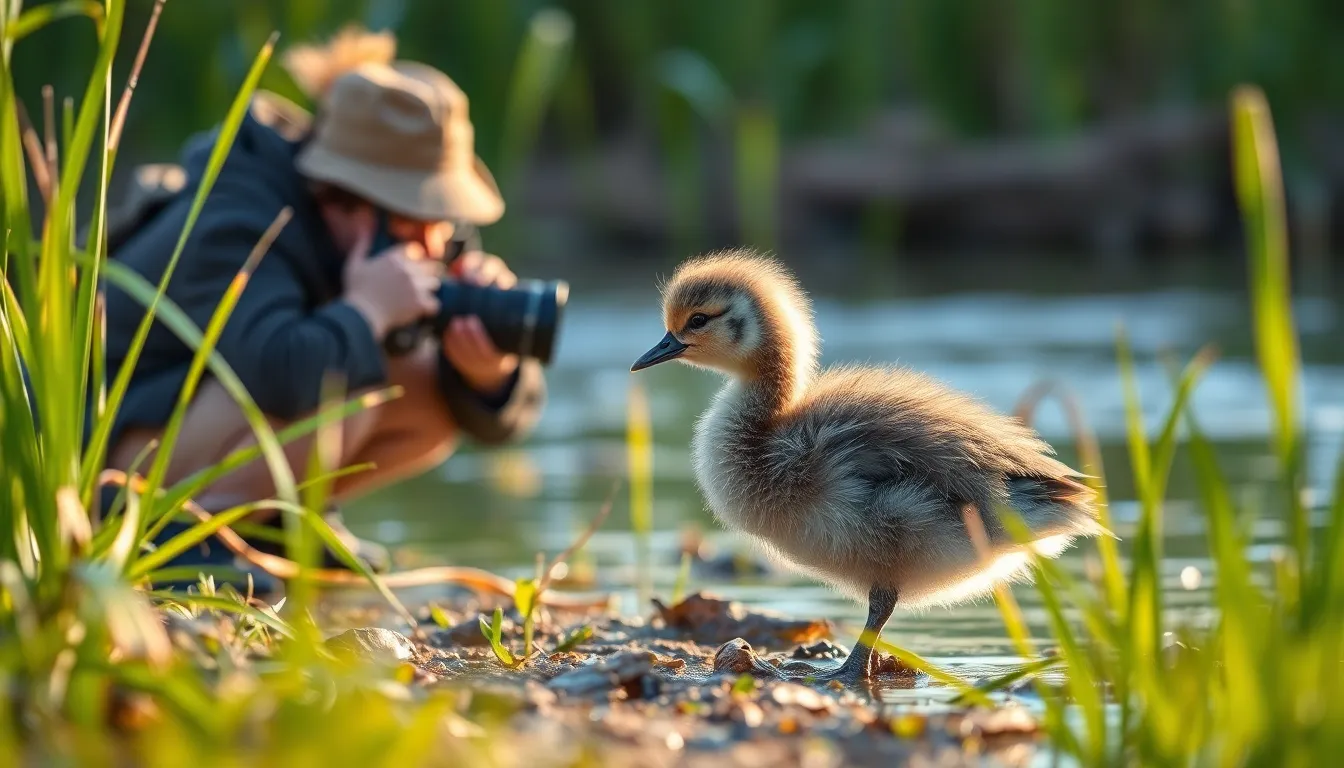
Capturing fluffy birds in their natural habitat requires strategic planning and specialized techniques to showcase their distinctive downy textures. We must consider timing, location, and camera settings to photograph these creatures effectively while respecting their natural behaviors.
Best Times and Locations
Early morning hours between 5:30 AM and 8:00 AM offer optimal conditions for photographing fluffy birds when they’re most active and their feathers appear freshly preened. We find that soft morning light enhances the texture of down feathers without creating harsh shadows that obscure fluffy details.
Golden hour periods before sunset provide another excellent opportunity as birds engage in evening preening routines. This timing allows us to capture fluffy species like owls preparing for nighttime activities or young chicks gathering near their parents for warmth.
Seasonal considerations significantly impact our success rates when photographing different fluffy bird species:
- Winter months reveal maximum fluffiness in Arctic species like snowy owls and ptarmigans
- Spring breeding season showcases enhanced plumage displays in male birds
- Early summer presents opportunities to photograph fluffy chicks and juvenile birds
- Late autumn captures birds developing their winter down coats
Location selection focuses on areas where fluffy birds naturally congregate. We target mixed woodland edges for owl species, wetland margins for waterfowl chicks, and open tundra regions for Arctic birds displaying extreme cold-weather adaptations.
Protected wildlife areas and bird sanctuaries provide controlled environments where we can photograph fluffy birds without disturbing their natural behaviors. These locations often feature established observation points that offer clear sight lines while maintaining appropriate distances.
Camera Settings and Techniques
Fast shutter speeds between 1/500s and 1/1000s freeze the subtle movements of fluffy feathers that flutter with each breath or slight head turn. We adjust our ISO settings between 800 and 1600 to accommodate lower light conditions while maintaining image quality that captures fine feather details.
Aperture settings between f/5.6 and f/8 provide sufficient depth of field to keep entire fluffy birds in sharp focus while creating pleasant background blur. Wide apertures like f/2.8 work effectively for isolating individual subjects against busy backgrounds but require precise focus on the bird’s eye.
Autofocus techniques benefit from single-point AF modes that target the bird’s eye area rather than relying on automatic subject detection. We configure our cameras to continuous AF tracking when photographing active chicks or birds in flight to maintain sharp focus on moving subjects.
Metering considerations account for the light-colored nature of many fluffy birds that can fool automatic exposure systems. We employ spot metering on the bird’s body or use exposure compensation between +1/3 and +2/3 stops to prevent underexposure of white or pale-colored down feathers.
Telephoto lenses ranging from 400mm to 600mm allow us to maintain respectful distances while filling the frame with fluffy bird subjects. These focal lengths compress background elements and create the shallow depth of field that emphasizes the three-dimensional quality of voluminous feathers.
Burst mode shooting captures multiple frames during brief moments when fluffy birds display their most appealing poses. We typically shoot 5-8 frames per second to increase our chances of obtaining images where all feathers appear perfectly positioned and undisturbed by wind or movement.
Fluffy Bird Behavior and Characteristics
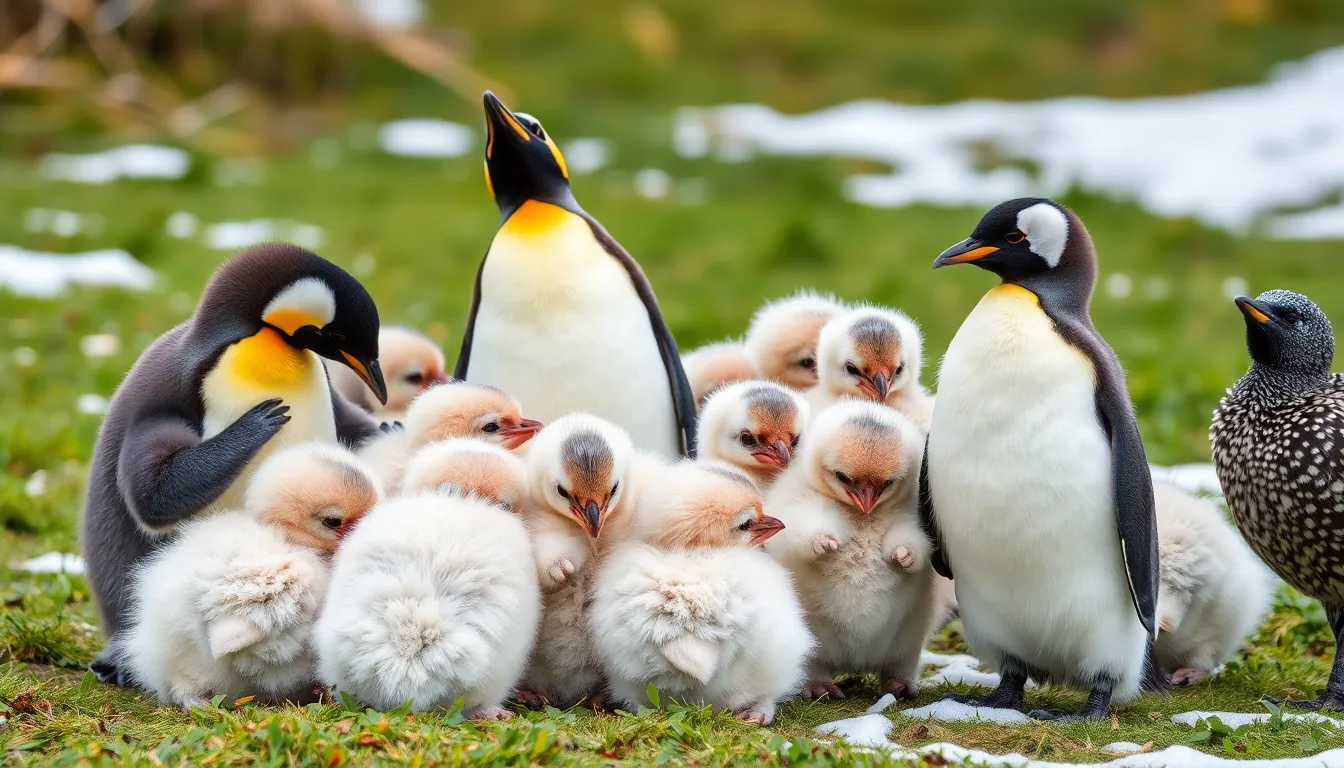
Fluffy birds exhibit distinct behavioral patterns that directly relate to their specialized feather structures and environmental adaptations. These behaviors demonstrate how their downy appearance serves multiple survival functions beyond simple insulation.
Preening and Feather Maintenance Behaviors
Preening rituals consume 15-20% of a fluffy bird’s daily activity time as they meticulously arrange their down feathers. Birds use their beaks to distribute natural oils from their uropygial gland throughout their fluffy plumage, maintaining waterproofing and insulation properties. Scratching motions with their feet help separate matted down clusters and remove parasites that might compromise feather effectiveness.
Dust bathing creates another essential maintenance behavior among ground-dwelling fluffy species like ptarmigans and quail chicks. Fine particles penetrate through the outer contour feathers to reach the dense down layer, absorbing excess oils and removing debris. Social preening occurs in colonial fluffy birds such as penguin chicks, where mutual grooming strengthens social bonds while maintaining feather condition.
Thermoregulation Behaviors
Fluffing responses occur when birds adjust their feather position to control body temperature throughout changing conditions. Cold exposure triggers immediate feather erection, expanding the insulating air layer by 40-60% within seconds. Heat stress causes feather compression against the body surface, reducing insulation and promoting heat loss through exposed skin areas.
Postural adjustments complement feather positioning as fluffy birds tuck their heads into their breast feathers during cold periods. Wing positioning changes create ventilation channels in warm weather, allowing air circulation through the dense down layer. Behavioral thermoregulation includes seeking microclimates such as sunny spots during cold mornings or shaded areas during peak heat.
Social Interaction Patterns
Communication behaviors in fluffy birds often involve feather positioning signals that convey emotional states and intentions. Aggressive displays include feather compression to appear sleeker and more aerodynamic during confrontations. Submission behaviors feature maximum fluffing to appear non-threatening and juvenile-like to dominant individuals.
Huddling behaviors maximize the collective insulating power of multiple fluffy birds during extreme weather conditions. Emperor penguin chicks form dense clusters where the combined down insulation creates temperatures 20°C warmer than ambient conditions. Rotational movement within huddles ensures equal access to warmth distribution among all participants.
Foraging and Movement Adaptations
Foraging efficiency decreases in extremely fluffy birds due to reduced aerodynamic capabilities during flight or rapid movement. Young fluffy birds compensate by adopting ground-based foraging strategies that minimize energy expenditure. Hopping gaits replace running motions in heavily down-covered species to prevent overheating during active periods.
Flight patterns change dramatically in seasonally fluffy birds as their increased bulk affects lift generation and maneuverability. Arctic species like snowy owls adopt slower, more deliberate flight styles during peak fluffiness periods. Gliding behaviors increase to conserve energy when additional down feathers create drag during powered flight.
Predator Avoidance Strategies
Camouflage behaviors rely heavily on the cryptic coloration patterns within fluffy feather structures to blend with surrounding environments. Freezing responses become highly effective as the irregular outline created by fluffy feathers breaks up the bird’s silhouette against natural backgrounds. Color-changing capabilities in some species like ptarmigans coordinate with seasonal fluffiness cycles for optimal concealment.
Distraction displays use the enhanced visual impact of fluffy plumage to draw predator attention away from vulnerable areas. Parent birds with fluffy breeding plumage create more dramatic broken-wing displays that effectively lead threats away from nesting sites. Mobbing behaviors in fluffy species appear more intimidating due to their enlarged apparent size when feathers are fully erected.
Conservation of Fluffy Bird Species
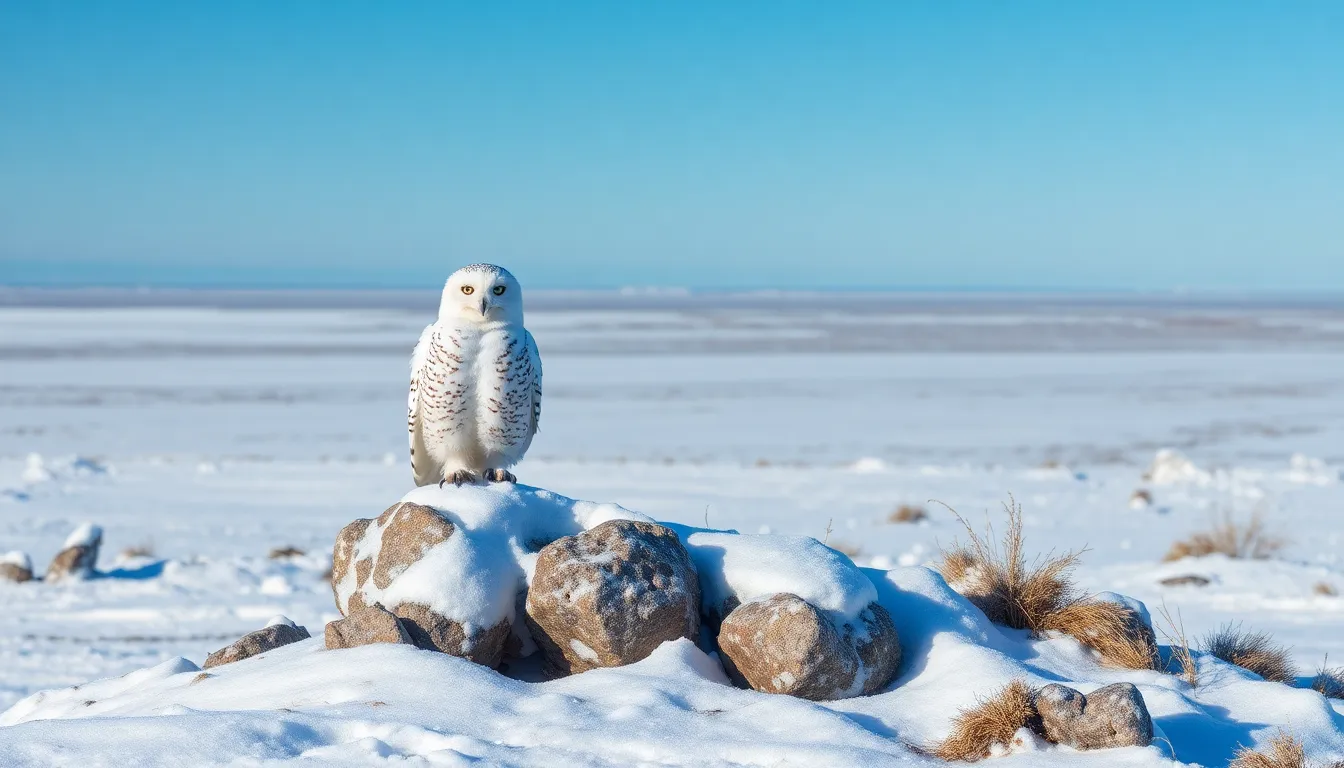
Conservation efforts for fluffy bird species face unprecedented challenges as climate change disrupts their specialized thermal adaptation mechanisms. Arctic species like snowy owls experience habitat loss when warming temperatures reduce prey availability by 40% across their traditional hunting grounds. Ptarmigan populations demonstrate similar vulnerability patterns, with alpine habitats shrinking at rates of 2-3% annually across North American mountain ranges.
Breeding success rates decline significantly when environmental conditions compromise the effectiveness of down feather insulation systems. Penguin colonies in Antarctica show reduced chick survival rates of 15-20% during years with extreme weather fluctuations. Young birds require stable temperature ranges for proper down feather development, making them particularly susceptible to environmental disruptions.
| Species | Population Decline % | Primary Threats | Conservation Status |
|---|---|---|---|
| Snowy Owl | 35% (last 20 years) | Habitat loss, prey reduction | Vulnerable |
| King Penguin | 28% (since 1990) | Ocean warming, food scarcity | Near Threatened |
| Ptarmigan | 45% (regional variations) | Alpine habitat loss | Declining |
| Gyrfalcon | 20% (Arctic regions) | Climate disruption | Stable-Declining |
Habitat preservation programs focus on protecting critical nesting areas where fluffy bird species maintain their breeding populations. Protected zones in the Canadian Arctic cover 12 million acres of tundra habitat specifically designated for species with specialized down feather adaptations. Marine protected areas around penguin colonies extend feeding ranges by establishing fishing restrictions within 50-kilometer radii of major breeding sites.
Captive breeding initiatives support population recovery through specialized facilities designed to accommodate fluffy bird requirements. Research centers maintain controlled environments with temperature ranges matching natural habitat conditions, ensuring proper feather development in captive populations. Reintroduction programs have successfully restored barn owl populations in 8 European countries through careful monitoring of juvenile down feather molting cycles.
Monitoring technologies enable researchers to track fluffy bird populations across remote habitats using satellite telemetry and automated camera systems. Data collection methods include feather sampling to assess health indicators and stress hormones that affect down feather quality. Scientists document seasonal fluffiness variations to understand adaptation responses to changing environmental pressures.
International cooperation frameworks coordinate conservation strategies across migratory routes and shared habitats. The Arctic Council’s biodiversity working group includes exact protocols for fluffy bird species protection, addressing transboundary conservation needs. Treaty agreements between 15 nations establish protective measures for penguin colonies and Arctic bird populations through coordinated research and habitat management programs.
Human activities pose direct threats to fluffy bird conservation through industrial development and recreational disturbances in sensitive habitats. Wind energy installations require careful placement to avoid migration corridors used by species with specialized flight adaptations related to their voluminous feather structures. Tourism management balances wildlife viewing opportunities with protection measures that prevent disruption of critical behaviors like preening and thermoregulation.
Restoration projects recreate suitable habitats for fluffy bird species through native vegetation planting and wetland reconstruction efforts. Successful programs in North Dakota have restored 50,000 acres of prairie habitat, supporting recovering populations of ground-nesting species with distinctive down feather adaptations. Artificial nesting structures provide alternative breeding sites when natural cavities become scarce due to deforestation and urban development.
Community engagement programs educate local populations about fluffy bird conservation needs and encourage participation in citizen science initiatives. Volunteer monitoring networks document seasonal abundance patterns and breeding success rates across 200 monitoring stations in North America. Educational outreach efforts highlight the ecological importance of species with specialized feather adaptations and their roles in maintaining network balance.
Conclusion
We’ve journeyed through the enchanting industry of fluffy birds and discovered that their adorable appearance serves far more purposes than simply melting our hearts. These remarkable creatures have evolved sophisticated adaptations that ensure their survival in challenging environments while maintaining the downy charm that captivates us all.
From understanding their specialized feather structures to learning about proper care techniques and photography methods we now appreciate the complexity behind their seemingly simple fluffiness. Whether we’re observing Arctic specialists like snowy owls or photographing baby chicks in our backyards each encounter offers new insights into these fascinating adaptations.
As we face ongoing conservation challenges it’s clear that our role in protecting these species has never been more critical. By supporting habitat preservation efforts and participating in citizen science initiatives we can help ensure that future generations will continue to experience the joy and wonder that fluffy birds bring to our industry.
Frequently Asked Questions
What makes birds appear fluffy?
Birds appear fluffy due to their specialized down feathers, which lack the interlocking barbule system found in regular feathers. This creates a soft, cloud-like texture by trapping air effectively. Young birds have abundant down feathers, making them particularly fluffy, while powder down in certain species further enhances their soft appearance.
Which birds are considered the fluffiest?
The fluffiest birds include owls (barn owls, snowy owls), baby birds like chicks and ducklings, penguin chicks, and cold-climate species such as ptarmigans and gyrfalcons. These birds have developed exceptional down feather coverage for insulation, protection, and survival in their respective environments.
Do birds get fluffier during winter?
Yes, many bird species grow extra down feathers during winter for better insulation, making them appear puffier. Arctic birds like snowy owls and ptarmigans exhibit extreme seasonal fluffiness to survive cold temperatures. They typically molt these additional feathers in spring when temperatures warm up.
Why did fluffy feathers evolve in birds?
Fluffy feathers evolved as evolutionary adaptations to address critical survival challenges. They provide exceptional thermal regulation by trapping warm air, offer protection against environmental hazards and predators, aid in camouflage, and help parents recognize their young through specific down patterns.
How should I care for fluffy pet birds?
Fluffy pet birds require spacious enclosures with proper temperature control and ventilation to prevent overheating. Daily misting helps maintain optimal feather condition, while allowing natural preening behaviors is essential. Provide dietary supplements and environmental enrichment to promote healthy feather maintenance and overall well-being.
What’s the best way to photograph fluffy birds?
Photograph fluffy birds during early morning or golden hour for optimal lighting. Use telephoto lenses with fast shutter speeds and appropriate ISO settings. Burst mode shooting helps capture perfect moments. Consider seasonal variations when their fluffiness peaks, and focus on showcasing their distinctive downy textures.
How do fluffy birds behave differently?
Fluffy birds spend significant time preening and dust bathing for feather maintenance. They adjust feather positions for thermoregulation and engage in social huddling for warmth. Their increased bulk affects movement and flight patterns, while their fluffy appearance aids in camouflage and predator avoidance strategies.
Are fluffy birds endangered?
Many fluffy bird species face conservation challenges due to climate change and habitat loss. Arctic species like snowy owls and ptarmigans are particularly vulnerable, with declining populations due to reduced prey availability and shrinking habitats. Conservation efforts include habitat preservation and captive breeding programs.

